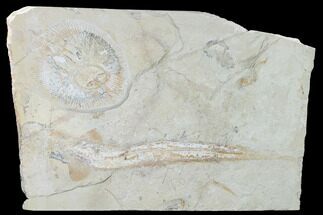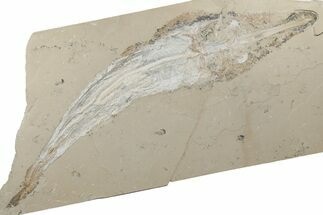This Specimen has been sold.
13.5" Cretaceous Ray (Rhombopterygia) Fossil With Fish & Shrimp
This is an exceptionally well preserved, 13.5" long fossil ray (Rhombopterygia) from the Upper Cretaceous deposits near Hjoula, Lebanon. It is beautifully centered on a slab of limestone that has been backed with concrete board for stability. Not only does this specimen feature a ray, there are also two shrimp (Carpopenaeus sp.), a crusher fish (Coccodus sp.) and a fish of the genus Gaudryella. This phenomenal natural association of marine fossils is truly a sight to behold, and would make for a stunning addition to any fossil collection.
Comes with a metal display stand.
Measurements:
Limestone - 25 x 13"
Ray - 13.5 x 7.7"
Crusher fish - 2.5" long
Fish - 2.4" long (straightline)
Shrimp - 3" and 1.2" long
Restoration is minimal and only occurs through repaired cracks where the rock broke during collection. One of these cracks runs through the body of the ray, though gap fill through the fish is extremely miniscule.
Comes with a metal display stand.
Measurements:
Limestone - 25 x 13"
Ray - 13.5 x 7.7"
Crusher fish - 2.5" long
Fish - 2.4" long (straightline)
Shrimp - 3" and 1.2" long
Restoration is minimal and only occurs through repaired cracks where the rock broke during collection. One of these cracks runs through the body of the ray, though gap fill through the fish is extremely miniscule.
Rhinobatidae is a family of rays, commonly referred to as guitarfish. They are known for their elongated bodies with flattened heads and torsos, and small ray-like wings. The combined range of the various species covers tropical, subtropical, and warm temperate waters worldwide.
The discovery of amazingly preserved marine fossils near Hjoula, Lebanon dates back many centuries. In fact, they were first mentioned in writing by Herodotus, over 450 years before the birth of Christ. The first scientific work on these localities began in the 1800s: these deposits have been meticulously quarried by several Lebanese families for over a century. We purchase our specimens directly from one of these families.
These deposits represent a warm, shallow sea of the Middle Cretaceous, and have yielded over 70 types of fish and numerous other genera found nowhere else in the world. The preservation on many of these specimens is truly amazing: many examples of soft bodied preservation have been found.
These deposits represent a warm, shallow sea of the Middle Cretaceous, and have yielded over 70 types of fish and numerous other genera found nowhere else in the world. The preservation on many of these specimens is truly amazing: many examples of soft bodied preservation have been found.
SPECIES
Rhombopterygia sp. (Ray), Coccodus sp. (Crusher Fish), Carpopenaeus sp. (Shrimp) & Gaudryella sp. (Fish)
LOCATION
Hjoula, Byblos, Lebanon
FORMATION
Sannine Formation
SIZE
Ray: 13.5" long. Limestone: 25 x 13" limestone
CATEGORY
SUB CATEGORY
ITEM
#201862
We guarantee the authenticity of all of our specimens.
 Reviews
Reviews

















